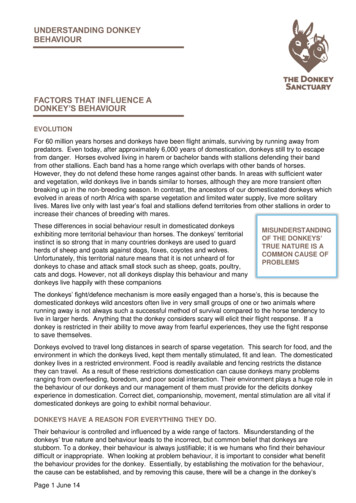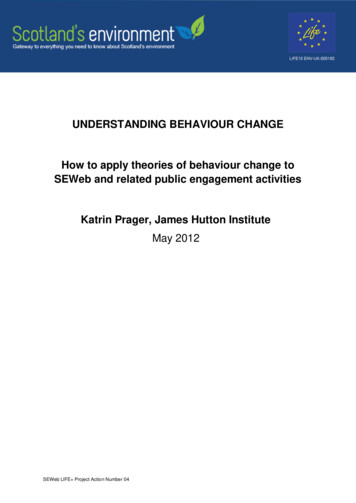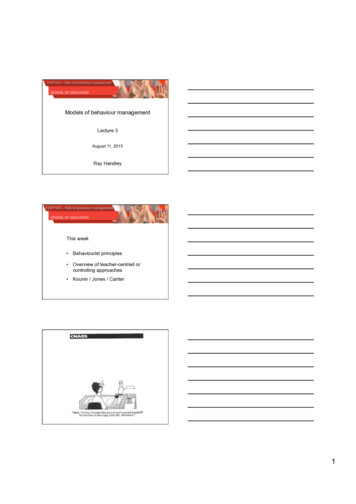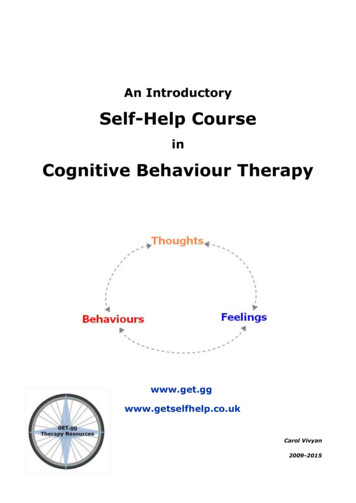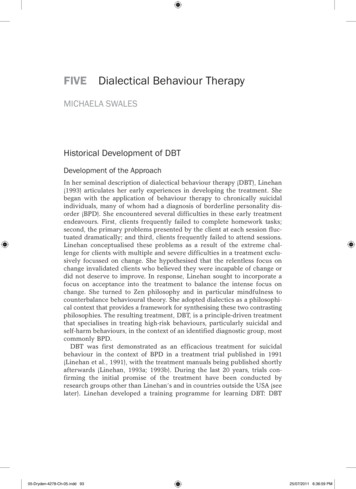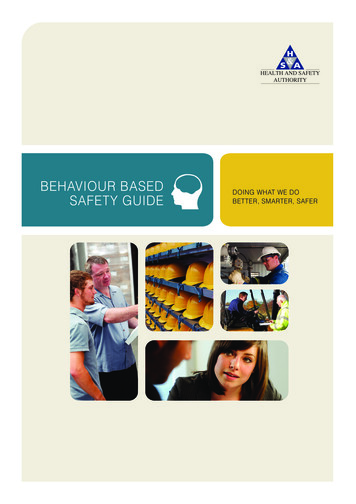
Transcription
BEHAVIOUR BASEDSAFETY GUIDEDOING WHAT WE DOBETTER, SMARTER, SAFER
Our vision:A country where worker safety, health and welfareand the safe management of chemicals are centralto successful enterpriseForewordMore and more we need to look at newapproaches to achieving safe and healthyworkplaces. We need to apply the learningfrom the many years of analyses of accidentsand ill health because this will contribute tofuture prevention strategies and activities.Behaviour Based Safety (BBS) is an approachthat we believe can be applied successfully; itis gaining more interest across industry sectorsglobally and has the great advantage ofneeding the involvement of the individualemployee, in addition of course, to employercommitment.How often have we experienced situations inwhich an employee’s competence in a workprocess is assessed at the point that they leavethe training room with the assumption that,once learned, the process will be appliedcorrectly and safely?This fails to take account of the many factorsthat influence and reinforce learning andbehaviours. BBS addresses these factors. It isclosely linked to company culture and valuesand, most importantly, when it works, it is anexcellent tool to improve safety performance inthe workplace.In developing this guide we have beenprivileged to have worked with a group ofpeople from companies that are committed tothe principles of BBS and on whom we cancount to promote the message. We hope thatmany more employers and employees becomeinterested in the potential of the approaches setout and that we have added another useful andpractical tool for improving safety and healthperformance.Our thanks go to all who have been ofassistance, provided insights and shared theirconsiderable expertise to help in thedevelopment of the guide.Mary DorganAssistant Chief ExecutiveHealth and Safety Authority
CONTENTSIntroduction . . . . . . . . . . . . . . . . . . . . . . . . . . . . . . . . . . . . . . . . . . . . . . . . . . . . . . . . . . . . . . . . . .2What is a behaviour based safety (BBS) approach? . . . . . . . . . . . . . . . . . . . . . . . . . . . . .3Reinforcement . . . . . . . . . . . . . . . . . . . . . . . . . . . . . . . . . . . . . . . . . . . . . . . . . . . . . . . . . . . . . . . .5Reinforcement and Feedback . . . . . . . . . . . . . . . . . . . . . . . . . . . . . . . . . . . . . . . . . . . . . . . . .7Goal Setting and Feedback . . . . . . . . . . . . . . . . . . . . . . . . . . . . . . . . . . . . . . . . . . . . . . . . . . . .8What is Involved in a BBS Programme? . . . . . . . . . . . . . . . . . . . . . . . . . . . . . . . . . . . . . . . . .9Leadership influence . . . . . . . . . . . . . . . . . . . . . . . . . . . . . . . . . . . . . . . . . . . . . . . . . . . . . . . . .12Tips for successfully implementing a BBS programme in your workplace . . . . . . .14Case study . . . . . . . . . . . . . . . . . . . . . . . . . . . . . . . . . . . . . . . . . . . . . . . . . . . . . . . . . . . . . . . . . . .15Additions . . . . . . . . . . . . . . . . . . . . . . . . . . . . . . . . . . . . . . . . . . . . . . . . . . . . . . . . . . . . . . . . . . . .17References . . . . . . . . . . . . . . . . . . . . . . . . . . . . . . . . . . . . . . . . . . . . . . . . . . . . . . . . . . . . . . . . . .18Published in 2013 by the Health and Safety Authority, The Metropolitan Building, James Joyce Street, Dublin 1.
IntroductionVarious approaches have had reasonable successin reducing unsafe behaviours in the workplace.Some involve penalties; others involvesurveillance; others involve guidance, codes andprocedures to follow; others still are supportive andtraining-oriented.Some initiatives come from the employer, from thesocial partner organisations, from state regulatorybodies, and some worthwhile initiatives come fromindividual employees’ own insights, ideas, trainingand development activities around health andsafety.Most employers and employees in the area ofsafety will agree that the ultimate aim of a safetyinitiative is a “total safety culture”; however, thisconcept is rarely defined. A total safety culture is aculture in which:a)individuals hold safety as a ‘value’ and notjust a priority;b)individuals take responsibility for the safetyof their co-workers in addition tothemselves; andc)all level of employee are willing and ableto act on their sense of responsibility –they can go ‘beyond the call of duty’(Perdue, 2000).The following are some requirements for anyapproach to safety at work that brings aboutnoticeable, lasting results and contributes to a totalsafety culture:1. A strong management commitment towardsmaintaining and improving behavioural safety,witnessed in the regular acts of individuals atmanagement level.Behaviour Based Safety Guide22. Respectful, trusting, open communicationbetween management and employee groupsabout all aspects of safety in the workplace.3. An open, feedback-rich culture amongemployees, which enables employees toconsistently learn and grow.4. A commitment to improving the profile of andattitude to health and safety, and increasedemployee engagement in safety.5. An emphasis on safe and unsafe behaviour;not a sole dependence on lagging indicatorssuch as safety statistics.6. A strong, consistent, timely reaction to thediscovery of unsafe acts, whether they result ininjury or not. Safety incidents are viewed as anopportunity to learn and improve.7. Generally transparent and fair leadership fromall, including managers, supervisors, andowners.8. Awareness amongst all staff of different waysto consider or query human factors – how wedo what we do, and why.
What is a Behaviour-Based Safety(BBS) approach?This guide is informed by the field of BehaviourBased Safety (BBS), which is often describedas a bottom-up approach (frontline employees),with top-down support from safety leaders.A behaviour-based safety approach promotesinterventions that are people-focused and oftenincorporate one-to-one or group observations ofemployees performing routine work tasks, settinggoals carefully and giving timely feedback onsafety-related behaviour, coaching and mentoring.The initiatives have a proactive focus, encouragingindividuals and their work groups to consider thepotential for incident involvement, (accidents) andto assess their own behaviour as safe or unsafealways, no matter what.A BBS approach is one which: Is based on solid principles about engaging,motivating, assisting, reinforcing, andsustaining safe behaviours. Takes a systematic approach, examining themotivation underlying behaviours, in order toincrease safe behaviour. Is an ongoing effort; not ‘once-off’ provisions,but a new way of working that the safety leadermust continually promote for sustainable,positive results. Takes time to achieve; however, results can beobserved immediately due to the nature ofmeasurement involved. Emphasises increasing safe behaviours ratherthan focusing on length of time without injury.BBS programmes do not depend solely on‘lagging indicators’ (after the fact), and insteadshift the focus to ‘leading indicators’(preventative). Is not a substitute for an already existingcomprehensive health and safety programme;it is a supplementary tool that will enhance theeffect of already existing practices, and willallow for an objective measurement system. Aims to understand causes of incidents andnear misses and correct them through thebehaviour of relevant people. For example,reducing hazards often requires behaviourchange of managers and frontline workers,and equipment redesign involves behaviourchange of engineers.“BBS is about everyone’s behaviour, not justthe frontline” (Agnew & Ashworth, 2012)BBS stems from the field of organisationalbehaviour analysis. The focus in bothorganisational behaviour analysis and BBS isbehaviour. The overarching theme in behaviouranalysis and BBS is that behaviour is maintainedby what occurs after it (consequences).Many safety interventions in work settings focus onantecedents, or events that come before behaviourthat may evoke behaviour. For example, manywork settings rely heavily on training, safety signs,pep talks, toolbox talks, or pre-briefs. These can beeffective in activating behaviours initially, but it iswhat occurs after our behaviour that ensures thebehaviour will occur time and time again.For example, a toolbox talk addressingcorrect manual handling techniques mightresult in correct techniques on the day ofthe talk; however, over time employeeswill revert to old practices. This is becausenothing has occurred after their correctbehaviour to indicate that it is correct, orthat it has benefitted the individual or theorganisation to be so safety-conscious.3Behaviour Based Safety Guide
What is a Behaviour-Based Safety (BBS)approach?Within BBS, behaviour is explained in terms of the ABC model (Antecedent, Behaviour, Consequence).AntecedentBehaviourA stimulus or event thatoccurs before a behaviourin time. This stimulus orevent may result in thebehaviour. Work examplesinclude goals, policies,training, job aids, guides.ConsequenceAnything that wecan see anindividual do, or say.A stimulus or event that occurs after abehaviour in time. This consequencecould increase or decrease behaviour inthe future, depending on its reinforcing orpunishing properties. Work examplesinclude feedback, recognition, taskcompletion, goal achievement, rewards.Despite the fact that we rely heavily on antecedents, it is consequences that have thegreatest influence on behaviour.When we examine an incident report and askquestions around why a person behaved in a certainway, we tend to look at antecedents, or whatoccurred to ‘set off’ the behaviour. However, if weexamine the report with a view to consequences, wewill gain a clearer picture of why the behaviouroccurred. For example, if an eye injury occurred andthe individual was not wearing PPE, we need toexamine what were the consequences for wearingthe PPE (e.g., possible but not definite reduction ofinjury) and what were the consequences for notwearing PPE (e.g., immediate comfort, better visionon the job).-Examination of consequences can revealthat in some instances it is actually morepreferable to not wear safety equipment.It is the job of a safety leader to ensurethat it is more preferable to engage insafe behaviour.Behaviour Based Safety Guide4This guide will examine the process that occurswhen a consequence leads to increases inbehaviour, reinforcement, and how we can increasesafe behaviour through reinforcement. Thedocument will then outline steps to an effectivebehavioural safety programme, and will concludewith a case study highlighting the positive effects ofa BBS programme.
ReinforcementReinforcement occurs when a consequence thatfollows a behaviour makes it more likely that thebehaviour will occur again in the future.Therefore, a reinforcing consequence is one thatcauses behaviour to occur more frequently.-For example, the behaviour of puttingmoney in a snack vending machine and pressinga button has the consequence of the chosenfood item being distributed. The presentationof the food item functions as reinforcement forputting the money in and pressing the button.If the person using the vending machine actuallywanted the food item then they will repeat thisbehaviour in the future (because it wassuccessfully accomplished).Essentially, everything we do changes ourenvironment in some way (consequences).When the environment changes in a way thatwe like, then we will repeat the behaviour thatled to the change (reinforcement).We can increase performance through negative andpositive reinforcement. Negative simply means taking awaysomething (e.g., closing a window removesa cold breeze), and Positive means adding something (e.g.,turning on a light switch results in theaddition of light).Negative ReinforcementA lot of what we do is to avoid something, sowe behave to get rid of the thing we don’t want– this is negative reinforcement.For example, if you wear PPE to avoid a fine(that might occur for not wearing PPE), this isyou working under negative reinforcement.Your ‘wearing PPE’ behaviour has increased inorder to avoid a bad situation.Doing something to avoid punishment oraversive conditions will not inspire great orcreative performance. We get by, but we arenot motivated to improve – we are motivatedby fear! Working because we ‘have to’ will getsufficient performance, but working becausewe ‘want to’ will mean we get maximumperformance (Daniels, 2000).In many organisations, work is typically carried outunder negative reinforcement conditions (i.e.because we ‘have to’). This results in adequateperformance; employees do enough to satisfy acompliance standard, but they do not go that extramile. On the other hand, working under positivereinforcement conditions can result in employeesgoing above and beyond their job duties, andemployees will take personal account for safety. Ifemployees work under positive reinforcementconditions (i.e. because they ‘want to’), then theywill be: 1) working towards something good (asopposed to avoiding a negative), 2) motivated towork, which might result in 3) creative thinking,employing new strategies, successful decisionmaking, seeking more responsibility.5Behaviour Based Safety Guide
ReinforcementPositive ReinforcementIn work settings it is less common to seeindividuals working under positive reinforcementconditions; however, it is preferable. Positivereinforcement leads to durable behaviourchange, and happier employees!For example, if you wear PPE because you feellike you are contributing to safety in yourorganisation (by taking personal control ofsafety), you will be more likely to wear PPEwhen your boss is not present, in situations inwhich it is not mandatory, and you may wellbegin to exhibit other safe behaviours inaddition to this, voluntarily.Doing something that results in positivereinforcement promotes strong, durablebehaviour change, in addition to other newpositive behaviours.Behaviour Based Safety Guide6When we talk about reinforcement, we refer to theconsequence that increases behaviour as areinforcer. A reinforcer is anything that is added following abehaviour that increases that behaviour in thefuture. This could be recognition, praise, money, oranything at all that is provided after ourbehaviour. As a basic example, when two people arehaving a conversation, they are reinforcing eachothers ‘conversation’ behaviour. If one personstopped talking, then reinforcement would nolonger be present and the conversation wouldcease. Reinforcers are around us in ourenvironment and maintain our behaviours all ofthe time. A successful leader will identify their employeesreinforcers through observing what motivatestheir employees, and by trying out potentialreinforcers, for example, increasing positivefeedback to see if that increases safe behaviour.
Reinforcement and FeedbackFeedback is information given to an individual or agroup about their behaviour and its impact(Braksick, 2007), and is one of the most importantcommunication tools in helping people stayhealthy and safe. Feedback can take many shapesand forms, and generally in a work setting feedbackis a combination of positive and constructiveinformation.A feedback-rich environment enhances bothcommunication and motivation. Positive feedbackcan act as a consequence that increases behaviour(reinforcement). Feedback lets us know that we areperforming the correct behaviours – positivefeedback should be specific in pinpointing the exactbehaviours that warrant positive praise. Forexample, instead of saying “nice work Bill”, saying“Bill, your housekeeping skills are so impressive.My path is always clear walking through yourworkspace”, will convey exactly to Bill what he hasdone to impress the person delivering the feedback.If individuals receive feedback telling them that theyare doing ‘the right thing’, then they will most likelyincrease that behaviour, provided the feedback isspecific and genuine.feedback, and for the listener to receive thefeedback. If a person is habituated to receivingpositive feedback, when he/she receivesconstructive feedback indicating that a change inbehaviour is required, the person will make thechanges, particularly if a goal is set around the newbehaviour. We often ‘do’ incorrect things becausewe haven’t been shown how to do the correctthings.When delivering constructive feedback, remember:-Constructive feedback should be used as a toolto teach and learn the correct way to complete atask or ‘do’ a behaviour.-It should be viewed as a training mechanism,and if delivered correctly, employees shouldwant to receive constructive feedback.Using feedback in conjunction with goal settingprovides a clear objective for the individual, so acombination of goal setting and frequent feedbackproduces maximal behaviour change.Sometimes it is necessary to deliver constructivefeedback. Constructive feedback refers to whenclear non judgmental instructions are given to theindividual on what behaviours they need to changeto reach the desired behaviours’. If positivefeedback is delivered on a ratio of 5:1 toconstructive feedback, then it will be easierfor the communicator to deliver the constructive7Behaviour Based Safety Guide
Goal Setting and FeedbackResearch into motivation and behaviour changetells us that setting goals leads to better results andthat ‘what gets measured gets done’. A person whois encouraged to get sixty letters typed in a day isfar more likely to succeed than a person who is toldto ‘do their best’. Likewise, if there is any room forambiguous interpretation, it is crucial to elaborate,e.g., rather than saying ‘Overalls should be worncorrectly’, say, ‘Overalls should be done up to theneck with sleeves outside gauntlet gloves’. It isbetter to be specific than vague, to aim higher thanlower and to get participation and engagement fromthe start. Safety should always be at the core ofgoal setting: saying ‘Do it by Friday but do it safely’rather than ‘Do it safely but do it by Friday’ puts theemphasis on safety as the most important factor,not the deadline.Most research shows that when goal setting ismatched with feedback in a systematic way, thetarget behaviour change is even more likely tooccur. When setting goals, managers, supervisors,parents, teachers and bosses often forget thedelivery of feedback. If a person sets out to learnnew methods or systems, to reach a target, to striveto improve or re-skill in some way, they needfeedback. Setting a goal acts as an antecedent thatspecifies what goal-directed behaviour shouldoccur, and feedback acts as a reinforcer – the goalsets off the behaviour and the feedback reinforcesthe behaviour. Behaviour-based safety interventionsreinforce safe behaviour via one-to-one, group andsite-wide feedback.Goal setting means simply what it says: Choose a goal relating to an activity - on awarehouse floor, ‘use of machinery’ could be thetarget activity.Behaviour Based Safety Guide8 Then choose a goal for that activity, e.g. ‘alwaystravel at or below the recommended speed whenoperating a forklift truck’. Agree that goal with those using the machineryand those in that vicinity. Agree upon a measurement system to determineprogress towards the goal.In order for a goal to be ‘reasonable’, thoseperforming the behaviour must agree, to someextent, that it is reasonable. They may believe it tobe too high, or too hard, but they must, at a basiclevel, accept that it is do-able and that they canachieve it. In order for this to occur, a discussionmust take place to ensure that the goal chosen is aworthwhile one. Apathy and cynicism result whensilly or meaningless goals are chosen. So, the firstphase is to agree a goal activity and then set adifficult, but do-able, standard to be met, a timeframe in which to meet that target, and a way tomeasure goal-directed behaviour. For complexgoals, set targets in between so that the effort isstaggered incrementally. Ensure that people knowthe most efficient way to complete the task, that thenew goal is applied fairly, and that everyone knowswhat they have to do and by what deadline.
What is Involved in a BBS Programme?Having explored reinforcement, feedback and goalsetting, the next section of this guide will brieflyoutline the steps to a BBS intervention. It isrecommended that the reference section at the endof the document be consulted prior toimplementation of a BBS programme.1. A design team is createdThe most effective way to run a BBSprogramme is to initially set up a design team.The design team should consist ofmanagement and frontline employees, andeach member of the team should have heardabout BBS and volunteer to be on the team.This team will design the BBS system,however all employees will be involved inimplementation.2. Target behaviours are chosen fromsafety incidents, near miss reporting,safety audits and observationFirstly, the design team picks targeted areas/tasks. The team can use data that the sitealready has; results of safety audits, safetydata, information from safety meetings andinformal interviews with staff (from the past 5years if possible). This will provide a wealth ofinformation around areas in need ofimprovement. The team determine what wouldhave prevented the reported injuries; if it is notimmediately obvious the team use methodslike discussing how increased situationawareness might have affected the situation.From this analysis, the team will identifycritical safe behaviours for an observationchecklist.3. A critical checklist is developedThe checklist is comprised of the list of safebehaviours identified in the above step. Thelist can be shortened according to importanceof safety, frequency of occurrence,observability and overlap with other items onthe list. The list should be no more than 1sheet of paper (1 side). It helps to havedefinitions for everything that is beingmeasured on the back of the checklist – trynot to leave anything up to subjectiveinterpretation. The best way to know if thechecklist is useable is to observe an employeeworking, and see if all categories on the listcan be filled out in an observation. The list willneed to be revised a number of times before itcan be considered ready-to-use.4. Ensure that you have ameasurement systemThe measurement system for an observationprogramme is simply a frequency count ofsafe and risk behaviours during anobservation. Note of caution: measuring isan antecedent, and we need aconsequence in place to strengthen thebehaviour under measurement. Whenmeasurement is used effectively, the leadercan create an environment in which peopleactually want to be measured. This canhappen when positive consequences aredelivered based on the behaviour change thatis observed through measurement. Whenemployees receive specific, positive feedbackabout the results, then they will see a benefit,aim higher, and want to be measured.9Behaviour Based Safety Guide
What is Involved in a BBS Programme?5. Behavioural observations arecarried outConsider who will conduct the observations.Data shows that the most beneficial system isto have all employees involved in theobservation process. Behaviouralobservations increase safety behaviours ofthe observed but also the observer, soencouraging employees to conductobservations on each other will benefit allemployees. The team and all employees willneed to decide how often observations will beconducted. Will they occur across or withindepartments? Will a single task or employeebe observed, or a work area? Will you includecontractors? – if so, try to recruit them at thedesign phase.6. Feedback is deliveredThe process requires careful training ofemployees. The observer should summarisesignificant positive safety behaviours thatwere observed and then one or two areas thatrequire change. The feedback should bedelivered as soon as possible after theobservation (unless this poses a risk).Describe the behaviour observed, discussthe potential impact and listen to theobservee – this formula can be used for bothpositive and corrective feedback. In addition toindividual feedback by the observer, overallsite feedback should be delivered. The leadershould discuss the results of the observations(categorically, not personally) at safetymeetings, while also providing visualfeedback. The easiest and most effective wayto do this is through creation of a graph.Visual feedback helps us to see how we aredoing and also helps us to set goals. LeadersBehaviour Based Safety Guide10should respond with positive feedback aboutany improvements, and not respondnegatively to low numbers on graphs. Instead,they should encourage objective problemsolving.7. Make use of the dataYou now have valuable data that you can useto inform you on process changes. Build areview of the data into existing meetings andensure that all staff are informed of anychanges made based on the data, and thatthey know it was because of their contribution(as a group - no names are recorded).8. Set improvement goalsEmployees should be encouraged toparticipate in this, and the goals should berealistic and based on the current data. Setshort goals and ensure that each employeeknows what behaviour or process they needto work on to reach the goal (see goal settingsection of this guide). Remember to focus onthe safety process itself and not the results –attempting to manage results will ruin theintegrity of the programme. Instead of settinggoals to increase or decrease results, setgoals around the behaviours that lead tothese results (e.g., increase wearing of safetygoggles from 80% to 100%).Behavioural observations are an opportunity todeliver both positive and constructive feedback. It isa feedback session structured around observationof a particular behaviour or a set of behaviours, anda feedback-rich environment is one in whicheverybody is learning. An effective observationprocess offers:
What is Involved in a BBS Programme?-Feedback on the effectiveness of the safetyprogramme Improved safety practices of observers andobservees;-Social consequences for safety Increased situation awareness;-A baseline for setting improvement goals -Practice in observing and discussing safebehaviourProvides feedback on the effectiveness ofsafety processes; Provides a baseline to set improvementgoals; Provides a forum for recognition of positivebehaviours (McSween, 2003).There are numerous benefits of using a behaviouralobservation approach, and it is recommended thatthe reader consult the reference section of thisguide for examples of successful interventions.Some notable benefits of behavioural observationsare:11Behaviour Based Safety Guide
Leadership influenceBBS programmes are typically driven by frontlineemployees; however, supervisors and managersplay an integral role in promoting, modelling andreinforcing the programme. Without strong safetyleaders, a BBS programme will suffer, and theexpected positive results may not be observed.Managers and supervisors affect the work group inmany ways:1. Their own behaviour acts as a model forthose reporting to them.2. Their attitudes, witnessed in what they sayformally and informally, for instance in thecanteen as well as at the start of a shift in frontof senior managers, make their mark.3. The most important effect comes from whatthe supervisors really do and think, not whatthey say they do and think.4. They behave ‘on behalf of’ large groups ofemployees at times where time is short orenergy reduced. For instance, if employeesare tired, their behaviour very muchdepends on what the supervisor does, saysand accepts as reasonable from their groupof reportees.Safety is not flexible, yet supervisors and managershave to be. This is one difficulty with keeping astringent, consistent approach to safety: lettingsomeone do something unsafely even oncediminishes every other attempt to do it properly.Leaders and managers can show flexibility in othermatters, but not safety. Remember, there are twomain requirements for employees: Participation and engagement on safetyissues so that all employees are informedand can debate the issues.Total compliance with behaviours agreed tomost effectively reduce errors, all the time.Behaviour Based Safety Guide12Leaders play a very important role in the safetyprocess. Leadership should not consist of auditing aperformer but rather listening to the performer andasking questions, such as “are there any parts ofyour job that you don’t see the need to do?”.The leader’s job is to listen and learn from theiremployee – one of the best ways you can buildrelationships is to let somebody teach you(Uhl, 2012).With regard to the specific areas of BBS addressedin the current document, the leader plays particularimportant and essential parts in the process:1. ABC modelIt is the leader’s responsibility to identify andcommunicate antecedents and consequences tosafe and unsafe behaviour. If a leader canidentify why an unsafe act is occurring, and whatis maintaining the unsafe behaviour, then theleader is in a position to change conditions toensure that the alternative safe behaviourresults in more preferable consequences.Additionally, a strong leader will teach his/heremployees to conduct ABC analyses so that allemployees can identify consequences to safeand unsafe behaviour, and all can contributepositively to behaviour change.2. ReinforcementWhen consequences have been identified, astrong leader will assess whether reinforcementcan be implemented for the desired safebehaviours. That is, a leader will boost socialreinforcement for safe behaviours and assesswhether or not this increases the safe behaviour.A strong leader will listen to his/her employeesto see what they find important. For example, ifan employee is discussing how he/she came upwith a particular initiative, then a clever leader
Leadership influencecan surmise that the employee wantsrecognition for his input. If one-to-onerecognition is not preferable to an employee,then a leader
What is a Behaviour-Based Safety (BBS) approach? This guide is informed by the field of Behaviour-Based Safety (BBS), which is often described

